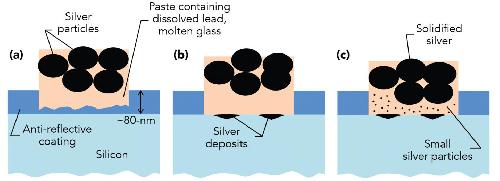Menlo Park, Calif. -- The silver electrical contacts that carry electricity out of about 90 percent of the solar modules on the market are also one of their most expensive parts. Now scientists from two Department of Energy national laboratories have used X-rays to observe exactly how those contacts form during manufacturing.
The results, reported in Nature Communications, are an important step toward finding cheaper alternatives to silver that don't require toxic lead for processing.
"Industry would like to get rid of both silver and lead in this process," said Mike Toney, a distinguished staff scientist at SLAC National Accelerator Laboratory and one of the lead authors of the paper. "One of the goals of this research is to figure out how the contacts are made and use this knowledge to come up with ways to eliminate silver and lead."
 This illustration shows how silver contacts form on silicon solar cells. a) Each contact starts as a glass paste that contains small silver particles (black) and lead oxide. As the temperature rises quickly during manufacturing, the glass paste melts, releasing lead ions that etch away the silicon's anti-reflective coating. b) At higher temperatures, silver ions migrate through the molten glass and deposit on the underlying silicon. c) Once cooled, the finished contact contains solid silver blobs that have been squeezed together by heat; tiny silver particles within the paste, which is now solid glass; and solid silver on the silicon surface. All three types of silver are needed to make the contact effective. Credit: SLAC National Accelerator Laboratory
This illustration shows how silver contacts form on silicon solar cells. a) Each contact starts as a glass paste that contains small silver particles (black) and lead oxide. As the temperature rises quickly during manufacturing, the glass paste melts, releasing lead ions that etch away the silicon's anti-reflective coating. b) At higher temperatures, silver ions migrate through the molten glass and deposit on the underlying silicon. c) Once cooled, the finished contact contains solid silver blobs that have been squeezed together by heat; tiny silver particles within the paste, which is now solid glass; and solid silver on the silicon surface. All three types of silver are needed to make the contact effective. Credit: SLAC National Accelerator Laboratory
Opening a Small Window on an Old Process
The contacts are produced by printing a paste made of silver particles, glass and lead oxide onto the solar cell's surface. The cell travels on a belt through a furnace, which heats it to about 800 degrees Celsius - 1,500 degrees Fahrenheit - in less than a minute. When the cell comes out the other end and cools, the lines of paste have formed electrical contacts with the cell.
"Although the process has been around for a long time, it's beenimpossible to see how the contacts form until now because it happens veryfast," Toney said. "Scientists have been debating how this reactionproceeds for many years."
To settle the debate, researchers from SLAC and the National Renewable Energy Laboratory (NREL) in Colorado built a simplified version of the industrial furnace at SLAC's Stanford Synchrotron Radiation Lightsource, a DOE Office of Science User Facility. They put sample solar cells into the furnace, quickly heated the samples to the high temperatures used in manufacturing and monitored changes in the chemistry of the contact with an X-ray beam shining into the chamber through a small window.
A Tool for Basic Research and Industry
The results showed that lead oxide plays a key role in forming the contact, etching away the solar cell's antireflective coating so silver can move through, pool and eventually harden in small pits on the silicon surface. Once cooled, the finished contact contains solid silver blobs that have been squeezed together by heat; tiny silver particles in a layer of solid glass; and solid silver on the silicon surface. All three types of silver are needed to make the contact effective.
"I won't say we have the full story yet, but this is the first time we actually got some insight into what's happening," said Maikel van Hest, a materials scientist at NREL who led the research. "Prior to this study we were only able to look at the contact before and after heat processing; what happened in between was like a black box. But now we can actually make measurements as the contacts form. This tool will have great impact in the photovoltaic industry as well as in basic research."
NREL's Jeremy Fields and SLAC's Mohammed Imteyaz Ahmad were first authors of the paper and played leading roles in carrying out the experiments. Other scientists involved in the research were NREL's Philip Parilla and SLAC's Vanessa Pool, Jiafan Yu and Douglas Van Campen. The research was funded by the DOE's SunShot Initiative, which aims to make solar energy cost-competitive with other forms of electricity by the end of the decade.
source: DOE/SLAC National Accelerator Laboratory